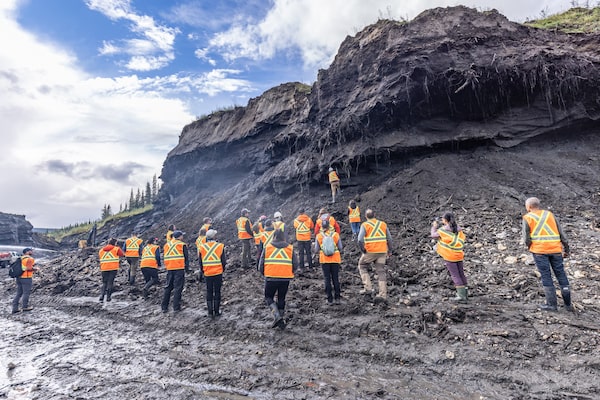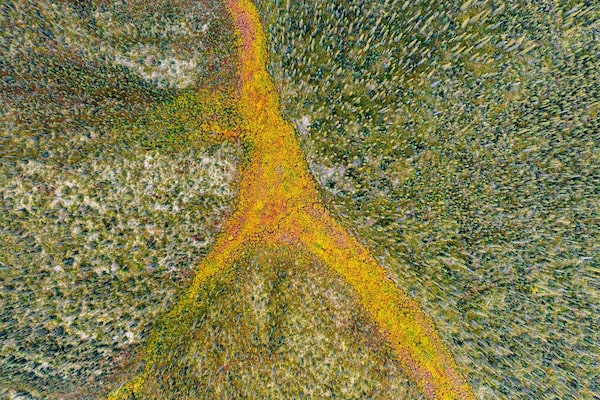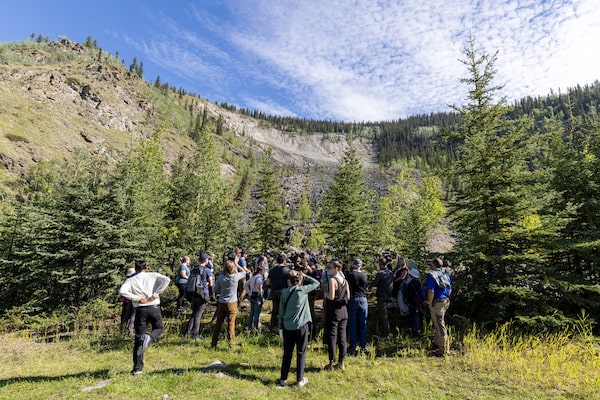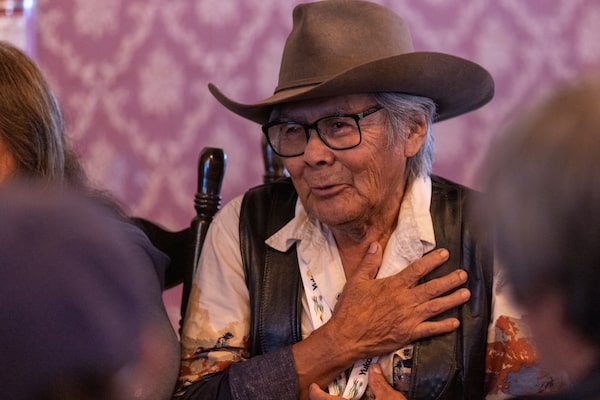
Attendees at a permafrost conference in Dawson City, Yukon, inspect a creek bank in the Klondike where ice-rich terrain has been washed away by placer mining. Climate change threatens to unlock the carbon in sediments such as this.Julien Schroder
Richard Littlemore is a Vancouver-based journalist, consultant, speechwriter, and co-author of Climate Cover-up: The Crusade to Deny Global Warming.
The Klondike capital of Dawson City is one of the best places in Canada to contemplate the catastrophic consequences of thawing permafrost. Or, if you’d rather, it might be a place to ignore the implications entirely, and with confidence that you are not alone in doing so. It depends on how closely you want to look – or how desperately you want to look away.
Most of Dawson – like 30 per cent to 50 per cent of Canada – is underlain by permafrost, which scientists define as ground that has remained frozen, winter and summer, for at least two years. The notion may seem chilly, even forbidding, in the south, but many northerners call permafrost “our concrete.” They use it as a base for roads and bridges, as the foundation for homes, churches and businesses. In the words of Steve Kokelj, a Carleton University geographer and one of the deans of the Canadian permafrost community, it’s “the glue that holds the northern landscape together.”
But if the promising prefix “perma-” suggests that this essential base is going to remain frozen forever, you might be disappointed. Thanks to climate warming, which a recent study by the Finnish Meteorological Institute showed is advancing in the North at up to seven times the global average, permafrost is thawing at an accelerating rate.
Which means that stuff is starting to break. The Northwest Territories Association of Communities said in 2017 that its annual bill for permafrost-related repairs was already $51-million – a big additional tax for a small population (44,800). And it’s going to get worse. A January study in Nature Reviews Earth & Environment predicted that permafrost-related damage will affect 30 per cent to 50 per cent of all northern infrastructure by 2050.
That’s obviously bad news for everyone who lives in one of the houses that is riding a permafrost thaw slump into the sea. But there is an even greater threat that hangs over us all.
According to Sue Natali from the Woodwell Climate Research Center in Woods Hole, Mass., there is currently between 1.4 trillion and 1.6 trillion metric tonnes of carbon trapped in northern circumpolar permafrost, the remains of plants and animals that, over many thousands of years, died and slipped below the surface, where they have remained frozen ever since. For scale, that’s roughly twice as much carbon as is currently contained in the world’s atmosphere, three times as much as in all the forests on Earth.
And when the permafrost thaws and micro-organisms start chowing down on all that suddenly available carboniferous material, those microbes wind up breathing out the greenhouse gas (GHG) carbon dioxide (CO2) or the even more powerful methane.
Next comes the truly dangerous turn, the self-reinforcing feedback that could become an irreversible global tipping point. The warming atmosphere hastens the thaw of the permafrost, which belches up more greenhouse gases, which further accelerates the warming – and so on into the crisis-ridden future. The short- to medium-term impact of this “permafrost carbon feedback” loop remains speculative and controversial but by one estimate, based on calculations from the U.S. National Oceanic and Atmospheric Administration’s 2019 Arctic report card, Canadian permafrost could be emitting greenhouse gases by 2050 at a rate equal to all of the country’s current human output. If we were including those GHG emissions in our national totals (we’re not), that would mean we would have to double our emission reductions and/or carbon-capture efforts to reach the federal government’s widely heralded target of net zero by 2050. It hardly bears considering.
In the slightly longer term, an overview paper published this month in the Annual Review of Environment and Resources reported that by the end of the century, even middling forecasts show that northern permafrost will be emitting carbon at a rate higher than the current output of any country other than China.

A drone's-eye view of the Yukon wilderness. Much of the land in this area lies on permafrost hundreds of thousands of years old that was never scoured by glaciers.Julien Schroder
Which brings us back to Dawson, where in late August the foremost permafrost experts in the country gathered with an unprecedented contingent of First Nations delegates for the North Yukon Permafrost Conference.
It is, again, a fitting venue. The fabled home of the Klondike Gold Rush, Dawson transformed in the late 1890s from a Dene community of a few hundred to a bacchanalian metropolis of up to 30,000 miners, revellers and hangers-on before crashing back down to its current permanent population of fewer than 2,000.
Honouring that history, the town presents as something of a theme park – though, because it is curated by Parks Canada as a National Historic Site, it looks more quaint than Disneyfied. By municipal decree, all the downtown building fronts must remain “in conformity with the architectural and landscape … style common in Dawson during and immediately following the ‘Gold Rush.’”
At a distance, the effect is pretty convincing. The landscape part is easy – 1890s-style dirt roads and rickety wooden boardwalks where the sidewalks might be. This is also robustly practical. The heaving permafrost and winter temperatures that frequently dip below -40 would quickly turn pavement or sidewalk concrete to rubble.
The buildings appear similarly authentic, as long as you don’t peek behind the facades to see the ones that are, in fact, corrugated-metal Quonset huts with false fronts. If you were to lift the skirts of the actual buildings, you also would find that nearly all of them are sitting on “cribbing,” beams and posts that can be shimmed and adjusted year after year to remain level, despite the permafrost decline. You don’t have to wander far from the main streets to see drunken, slewing (and ultimately dangerous) structures that have not been kept up.
“Most of us are used to relevelling our buildings quite a bit,” says Dawson Mayor Bill Kendrick. It’s more difficult, though – and even more expensive – to manage some of the other infrastructure, he says, offering the example of the sewer and water lines that snapped a few years ago, thanks to a four-foot, permafrost-driven “deflection” along Sixth Avenue.
These historic buildings in Dawson, shown in the mid-2000s, are smushing together as the permafrost thaws.Chris Beacom

Some of Dawson's more picturesque buildings, as seen at 2018's Canada Day parade.Darryl Dyck/The Canadian Press
So people in Dawson are hypersensitized to the local effects of permafrost – the geohazard. But many seem to actively ignore the implications of permafrost carbon feedback. Far from trying to protect the permafrost, to keep excess carbon in the ground, many dozens of placer mines are working tirelessly to destroy the permafrost layer, to get access to the gold that still lurks in Klondike gravel. The miners, usually in operations of four to six people, set up in creek beds and spray water at the banks, blowing off any surface flora and the layers of permafrost ice, soils and fossilized material to get to the good stuff. Then they sluice out the gold, thereafter covering the landscape with washed-gravel tailings that, from the plane coming in from Whitehorse, look like castings from Dune-sized sandworms.
According to the Yukon government manager of surficial geology, Jeff Bond, there are roughly 150 placer mining operations in the Dawson region, generating 90 per cent of the 80,000 ounces of gold that come out of the Yukon every year. At current gold prices, about $2,200 an ounce, that’s roughly $160-million worth of income, an estimated 87 per cent of which stays in the local economy. As Mayor Kendrick says, “When COVID devastated tourism, mining helped us weather the storm.”
Here, then, is an analogy for the whole climate-change dilemma: what you know versus what you don’t want to know. As in southern Canada, where governments set emission-reduction targets and then invest in oil sands pipelines or promote oil and gas developments, there is always the tension between an uncertain threat tomorrow and a reliable income today.
Against that tension, the Dawson permafrost conference was set up as a multifaceted act of reconciliation. First, of course, was the challenge of engaging and reconciling with the Indigenous people on whom the climate effects are having the most immediate and, often, devastating impact. Carleton University’s Chris Burn, another giant in the Canadian permafrost panoply, describes First Nations people in the North as “the last group who are not removed from the environment.” He says, “They realize that they are facing an existential problem, not just an interesting intellectual exercise.” Dr. Burn is also beloved in these parts as an academic who came to the Yukon to research permafrost in 1982 and has been coming back almost every summer since. Unlike too many academic researchers, who fly in with thousands of dollars of equipment and head straight into the field, neither tapping the locals for their insights nor sharing any knowledge gained in the process, Dr. Burn recognized early that “the observations of the people who actually live here are always more interesting than those I can make myself.” As if to drive home the point, 40 years later, he still gets ribbed for the unlikely riverbank location of his first camp.
So, in preparing for this conference, Dr. Burn and others from the Canadian Permafrost Association (CPA) invited First Nations to participate as co-organizers. Three First Nations accepted: the Trʼondëk Hwëchʼin, the Vuntut Gwichen, and the Na-cho Nyak Dun.
The outcome, according to current CPA president Kumari Karunaratne, was “amazing.” Knowing that a third of the people in the room would be First Nations elders, the scientists accepted a challenge to avoid jargon-filled, insider presentations. “They’re not dumbing it down,” Dr. Karunaratne said, “but they’re breaking it down enough to be understood.” And in the multidisciplinary world of permafrost science, that turned out to be a boon for other scientists, as well.

Participants at the Dawson permafrost conference listen to scientist Antoni Lewkowicz and Peggy Kormandy, a Tr'ondëk Hwëch'in elder, describe the Moosehide Slide north of town.Julien Schroder
That signals the second point of reconciliation – the drawing together of the permafrost science community and, especially, the co-ordination of permafrost research.
Like other dangerous climate forcings, the permafrost threat is so dispersed that no single jurisdiction can claim or exercise responsibility. Scientists, distributed among many institutions – and many countries – tend to work in isolation and, in Canada certainly, funding agencies prioritize short-term capital-intensive research projects, resisting long-term or operating grants. As a result, the Canadian permafrost research community has been relying on what University of Montreal geographer Oliver Sonnentag calls “a coalition of the willing,” in which “co-ordination is not funded and every person, every project is disconnected.”
Thanks to at least three initiatives, however, that may be about to change.
The first is being led by Carleton University geographer Stephan Gruber, who is the principal investigator for the Natural Sciences and Engineering Research Council Permafrost Partnership Network (NSERC PermafrostNet), which unites researchers from 11 universities, and partners with government agencies, industry, and Indigenous communities to monitor, predict and adapt to permafrost thaw and its consequences.
Dr. Natali and the Woodwell Center are driving an even larger research and co-ordination project called Permafrost Pathways, which is building a comprehensive international monitoring network to improve tracking and modelling of Arctic permafrost and carbon fluxes – i.e., how much carbon is being emitted from permafrost as opposed to that which is being absorbed as new plant material dies and is frozen in the annual cycle. Dr. Natali and company are working to partner with local leaders and to provide local and national policy makers with the data they need to fill gaps in monitoring and modelling permafrost thaw.
As mentioned above, permafrost emissions are not currently included in national carbon budgets, which means that emission-reduction targets negotiated at the 2015 Paris climate conference could be way off the mark as the world seeks to keep global warming from exceeding catastrophic levels.
The bad news in the Permafrost Pathways project comes in the sudden and unfortunate departure of Russia from international permafrost science collaboration, thanks to the diplomatic break driven by the Ukraine war. Two-thirds of the world’s permafrost lies within Russian borders, so permafrost researchers in the rest of the world are eager to restore the flow of scientific information.
In the meantime, there may be a greater opportunity to focus on Canadian monitoring and the Woodwell team has now engaged Dr. Sonnentag, who will be taking a leave from his University of Montreal teaching duties, beginning Jan. 1, to serve as a liaison to the Canadian research community.
The Cascade Institute at Royal Roads University is launching a third co-ordination project, called the Permafrost Carbon Feedback Intervention Roadmap, again seeking to expand the conversation and reduce the scientific uncertainties that some policy makers use as a rationale to delay action.
Even without working through the next stage of monitoring and analysis, however, Dr. Natali bridles at the continuing policy delay. She says, “Uncertainty is just a range of possibilities. It shouldn’t frustrate action.”
She also points out that we already understand the range of consequences and says that we should be making decisions based on the high end of the range, precisely because the possible consequences are so huge. (Dr. Gruber calls permafrost carbon feedback “a trillion-dollar question for coastal cities.”)
Dr. Natali concludes that, in the long run, “The science will give us the numbers. For decisions, we need the wisdom to come together as human communities.”

Jimmy Johnny, a Na-Cho Nyak Dun elder, speaks at the Dawson conference.Julien Schroder
One of the most popular sources of wisdom in Dawson was a Na-Cho Nyak Dun elder named Jimmy Johnny, a presenter in a panel discussion on climate-change adaptation. Mr. Johnny is a short, wiry and quietly mirthful character who has spent his life as a horse wrangler, having gotten his first job as a guide-outfitter in 1958. And he dresses the part: cowboy boots, hat, leather vest and blue jeans that stay up out of pure stubbornness, there being too little flesh on Mr. Johnny’s bones to stop them from falling down.
He told a story of a recent hunting trip in which a pack horse named Big Blue fell into a huge permafrost sinkhole: “Right before my eyes, he disappeared.” Tapping the strength of all hands and a couple of other horses, Mr. Johnny worked to pull Big Blue out, but the sloppy hole was too constricted and the horse too panicked. Facing a terrible decision, Mr. Johnny walked to a high point and phoned the horse’s owner – for permission, or maybe for his blessing. But the owner just said, “Jimmy, you’re the trail boss. You do what you have to do.”
Mr. Johnny walked back to his own horse and, to the consternation of the southern hunters in the party, he pulled a .30-30 rifle from his saddle. “And then I walked around behind the horse, so he didn’t have to see.”
But Big Blue was neither inattentive nor new to the world of hunters. When Mr. Johnny cocked the rifle – “click, click” – the horse bounded upward, not clear of the hole, but far enough that they were able to wrestle him the rest of the way.
The moderator for the adaptation panel was a Na-Cho Nyak Dun adviser named John Meikle, who noted that there is now ample evidence of the risks we all face from climate change, and the urgency of the call to action, concluding, “Maybe it’s time to take a lesson from Big Blue and imagine Jimmy Johnny standing behind you with a .30-30.”
It’s a rough metaphor, but the head-nodding and mirthless laughter that greeted Mr. Meikle’s comment suggest that, in this room, at least, there is wary consensus about the looming implications of climate change generally and permafrost specifically: Even if we’re not yet capable of jumping out of the hole, it might be time to stop digging.
Editor’s note: (Nov. 1, 2022): An earlier version of this article incorrectly said Woodwell Climate Research Center is linked to Harvard. This version has been corrected.
What is permafrost, and what happens when it melts across Canada?

The temperature of permafrost, which lies beneath an estimated 40% of Canada’s land mass, has increased during the last three or four decades. The nation’s official permafrost map, published in 1995, delineates the North into sprawling regions.
PERMAFROST TYPE
Isolated
Continuous
Subsea
Extensive discontinuous
Sporadic discontinuous

The temperature of permafrost, which lies beneath an estimated 40% of Canada’s land mass, has increased during the last three or four decades. The nation’s official permafrost map, published in 1995, delineates the North into sprawling regions.
PERMAFROST TYPE
Isolated
Continuous
Subsea
Extensive discontinuous
Sporadic discontinuous

PERMAFROST TYPE
Continuous
Extensive discontinuous
Sporadic discontinuous
The temperature of permafrost, which lies beneath an estimated 40% of Canada’s land mass, has increased during the last three or four decades. The nation's official permafrost map, published in 1995, delineates the North into sprawling regions.
Isolated
Subsea

Thawing permafrost alters landscapes
and threatens infrastructure built on it,
such as roads, buildings and pipelines.
The extent of that threat depends
on permafrost characteristics, which can
vary greatly even over small areas.
Continuous
Active
layer
Discontinuous
Sporadic-isolated
MATT MCCLEARN, JOHN SOPINSKI AND MURAT YÜKSELIR
source: Natural Resources Canada, GRAPHIC NEWS

Thawing permafrost alters landscapes and threatens infrastructure built on it, such as roads, buildings and pipelines. The extent of that threat depends on permafrost characteristics, which can vary greatly even over small areas.
Continuous
Active
layer
Discontinuous
Sporadic-isolated
MATT MCCLEARN, JOHN SOPINSKI AND MURAT YÜKSELIR
source: Natural Resources Canada, GRAPHIC NEWS

Thawing permafrost alters landscapes and threatens infrastructure built on it, such as roads, buildings and pipelines. The extent of that threat depends on permafrost characteristics, which can vary greatly even over small areas.
Continuous
Discontinuous
Sporadic-isolated
Active
layer
MATT MCCLEARN, JOHN SOPINSKI AND MURAT YÜKSELIR
source: Natural Resources Canada, GRAPHIC NEWS